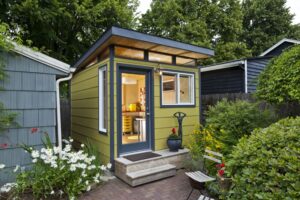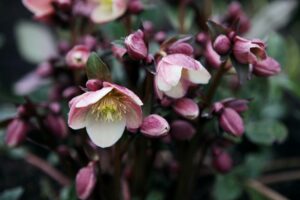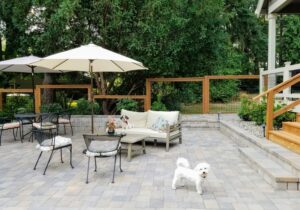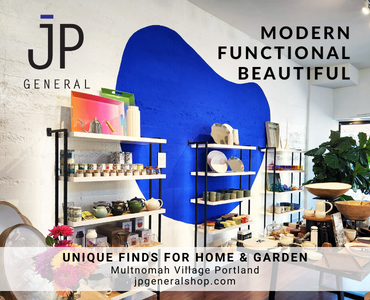Are you a foodie who craves the taste of a just-off-the-vine cherry tomato? Or maybe you’re thinking about growing your own veggies to slash your grocery tab during these penny-pinching times? Oregon Home asked a longtime victory gardener, two landscape designers and a professional backyard farmer to detail how you can transform a typical backyard into your own private farmer’s market.
[1. if you plan on having a raised-bed garden, think outside the lumber-edged box.]
Step away from the wooden stakes and balls of twine you were planning to use to mark off the rows of rectangular raised beds across your front yard and rethink what a lineup of boxed-off beds will do to your home’s curb appeal. “If you don’t absolutely need a straight-edge border, you can do lots of things,” says Dreya Mancini, a landscape designer and the co-owner of Seed Garden Designs in Portland. “You can have a raised bed with sides that aren’t enclosed by a box. You can maintain its shape, but it won’t be a perfect edge.
An alternate option, Mancini says, is to make ‘keyhole’ beds. “When you do a traditional bed, you need to give a lot of space to the path around them,” she says. “Depending on the size of your yard, it can be difficult to access what’s in the center. A keyhole bed is circular like a keyhole. That makes the bed accessible from all sides and requires less space for paths.”
[2. Don’t play the “If only I didn’t have A family and a job!” card for why you’re not gardening.]
An edible garden is like any other type of landscape. Once established, you don’t need to devote all your free time to maintaining it. “A victory garden needs to become part of the flow of your daily life,” says Laura Lyon, who has a big finance job (and a husband and a child) yet tends a 1,192-square-foot edible garden in Poulsbo, Wash., from which she harvested 600 pounds of food last year. She details her gardening life in her inspiring website The Modern Victory Garden (go to modernvictorygarden.com).
“Your garden should see you every day,” she says. “That doesn’t mean that you have to spend hours in it each day, but pay attention, make mental notes of things that need to be done and harvest the produce as it’s ready. Of course, when things need to be harvested, you will be spending more time in the garden, but if you understand how it works, you’ll be able to plan for those times.”
[3. Get real about how much you spend each week on fruits and veggies.]
A recent study in the Journal of the American Dietetic Association shows that Americans typically spend 15 percent of their food budget on fruits and vegetables. These days, $15 will buy you a bunch of basil, a head of romaine, a pint of cherry tomatoes, a couple of peppers and a pineapple at many neighborhood grocery stores. Yet the government’s dietary guidelines recommend that you eat nine servings of fruits and vegetables a day, which dieticians say will help to keep heart disease, diabetes and cancer at bay.
Growing your own vegetables also gives you the opportunity to stretch your dollars to buy vegetables that you couldn’t have afforded with the veggie allotment of your grocery bill. “We did a study on this,” says Donna Smith, a co-owner and a farmer at Your Backyard Farmer in Portland, which helps people turn yards into farm plots. “If you have $20 to spend on vegetables, you’ll just get the most often eaten vegetables such as lettuce and tomatoes. But in a home garden, you increase the value of that money. Instead of one head of lettuce, you have different kinds. If you’re growing items that you used to buy, you can shift money to the things you want to have, but can’t grow.”
[4. If you plan on growing plants from seeds, rig up grow lights to do the job properly.]
Starting seeds indoors can give you a head start on your garden, extend your growing season and increase the number of vegetables you grow since most nurseries offer more varieties of seeds than they do of starts. “Growing seeds indoors isn’t incredibly technical, but don’t be casual about it,” says Gerald Kubiak, the owner and the operator of City Steward, a landscape design and construction company in Portland, who advocates growing vegetables, fruits and herbs in your yard. “Make sure the room is warm and well-lit with lights designed for growing plants. It’s best if the room is south-facing, which provides plants a consistent temperature in the mid-70s. If you’re set up properly, you can start seeds indoors as early as February.”
 [5. Pay attention to the content of hardscape materials, especially if you plan on growing organic food.]
[5. Pay attention to the content of hardscape materials, especially if you plan on growing organic food.]
Before you dash off to a home improvement store to purchase pressure-treated lumber, think about whether that’s the best choice for your yard and its aesthetics, especially if you plan on gardening organically. “You might not want to have chemically treated lumber edging the soil in which you’ll garden if you’re planning an organic garden,” says Kubiak. “If you want to make a wood-edged raised bed, use cedar planks or salvaged wood, which looks beautiful and weathers nicely, or use reclaimed bricks in an artful way.”
[6. Know that a small garden can still deliver good yields.]
You may not be able to meet all your vegetable needs, but you can meet a lot of them in a small space. “When we work with clients, we ideally like to have a 10-by-10-foot space for each adult in a family if the family wants to have year-round produce,” says Smith. “But there’s a lot you can do with a small garden. We spend a lot of time planning how to best use your space. If you like salads and you have a two-foot area you can plant in, grow the lettuces that you eat a lot. You can’t grow much cauliflower in two feet, but you can have lots of lettuce.”
[7. Design your edible garden with the same care you would a traditional landscape.]
Spend time planning how your vegetable garden will look. “An edible garden has a utility value, but you don’t have to lose the aesthetic value,” says Kubiak. “Plan variations in color, patterns and heights.” Berry bushes and strawberries can be beautiful additions to a landscape. Strawberries are low-maintenance and are a good ground cover. It doesn’t take a lot of extra effort to work these plants into your yard.”
[8. Don’t plan a garden that will be too large for you to manage.]
Dream of tearing out your lawn and turning it into your own private farmers’ market? If you haven’t done a lot of gardening, begin with a small plot. “Start small and learn your skills,” says Lyon. “It’s okay to have big ambitions, but really learn to garden. Your first garden may not be huge, but it’ll be a step in the right direction.”
[9. Learn which vegetables are best to grow from seed and which ones you should buy as plants.]
When planning your garden, it’s important to decide which plants you’ll grow from seeds and which ones will be starts. “Some crops are easy by seed, and some are easier to grow from starts,” says Mancini. “For example, climbing peas are easy to grow from seed and don’t require much attention. Tomatoes, you can do from starts, but carrots, you should always do from seed.”
[10. Prepare your soil.]
While compost and organic soil and fertilizer are common tools in the gardener’s arsenal, there are additional things you can do to get the best yield from your plants. “I like to use sheet-mulching, which lets you plant on top of the ground,” says Mancini. “I use layers of newspaper, compost and a material such as straw, which creates a good environment for the bacteria and worms you want in your garden.”
You can also improve your soil with the plants you choose. “Plant things that have hearty taproots or do a cover crop, mulch it and plant again,” says Mancini. “Another thing you can do is to plant a nitrogen-fixer from the legume family, such as fava beans, in the fall as a cover crop, which will make your soil more nitrogen-rich.”
[11. Make plans for your delicious bounty.]
If you’re going to go to the trouble to put in an edible garden, make sure you use what you planted. “We incorporate a lot more produce into our daily diet with the garden,” says Lyon. “In the summer, our meals are often mostly plant-based. I rarely buy vegetables in the grocery store. I do most of my cooking from scratch and incorporate recipes that use my produce in season.”
[12. If necessary, alter your yard to support an edible garden.]
Whether you’re adding a separate vegetable garden or integrating edible plants into an existing landscape, make sure your yard is designed so that the plants get all the resources they need. “A lot of edibles need at least six hours of sunlight,” says Kubiak. “If you have an area of your lawn that you rarely use that’s in a good location, remove the grass to put in vegetables.”
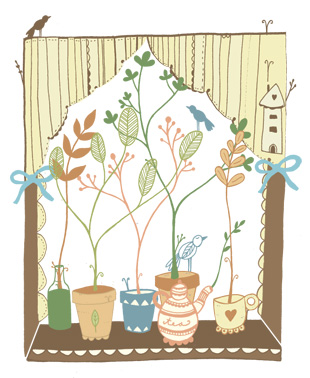 [13. Grow herbs.]
[13. Grow herbs.]
Squash, carrots and berries are obvious things to grow, but tuck in herbs and medicinal plants among the produce. “Some people use plants as medicine, so they incorporate plants that are good for making balms for medicinal purposes or have leaves that are good for tea.” says Mancini. “If you’re growing a lot of food, then plant the herbs you’ll need to prepare your harvest with.”
[14. Plant a variety of veggies to ensure many months of harvest.]
While late summer and early fall are often seen as the harvest seasons for gardens, you can have a garden that produces all year. “Do succession planting to keep the harvest peak from overwhelming you,” says Lyon. “The Northwest climate allows many people to have a four-season garden. The garden you have in February may not yield as much as it did in the fall, but you can still eat from it.”
[15. Plan ahead to avoid having a bumper crop of green tomatoes in fall.]
If your previous tomato-growing experiences left you with few tomatoes during the summer and a huge crop of hard-as-rocks green tomatoes in the fall, plant a handful of different varieties of cherry tomatoes. Plant several different kinds to make sure you have enough to see you through the season.
“Tomatoes are more of an art than a science,” says Kubiak. “Cherry tomatoes are lower maintenance and produce a big yield. There are heirloom varieties you can plant that are tastier and just as hardy and that will take you through the season.”
[16. Ensure your garden gets the water it needS.]
An irrigation system can ensure that your vegetables will thrive, but there are other ways to make sure the plants get the water they need. “If you have a landscaped area with an edible section, dig a hole and place an unglazed ceramic pitcher with a lid in the ground in that area,” says Mancini. “The water will slowly be released into the ground for the plants around it. Choose a decorative pitcher and have its edge show above the hole. Just refill the water as it empties.”
[17. Grow up!]
While standard beds and plots are great ways to grow edible plants, a little vertical integration can give you a higher yield in the same amount of space. “I have a large yard with what I call a Food Forest,” says Mancini. “I use different heights for growing different things. I have apple and pear trees, a raspberry patch and a vegetable patch. When I work with clients, I try to incorporate layers into the designs. We might add an arbor with yellow squash, which adds a nice visual aspect. I also do custom trellises that have an edible vine with an evergreen vine to provide color all year. When you take gardening above the level of a raised bed, you can incorporate a lot more to eat and a lot more that’s interesting to look at.”
[18. As your palate changes, change your garden.]
As you learn more about gardening each year, you’ll also be able to make changes to your garden as your tastes change.
“What you like to eat will drive what you grow in your garden, but there’s a lot of room for experimenting,” says Lyon. “You can change varieties or vegetables or try some new plant you’ve just heard about. I have standbys that do well for me, but I’ll often rotate in a variety I’ve never grown before. The beauty of gardening is that you can always start over again next year.” n






